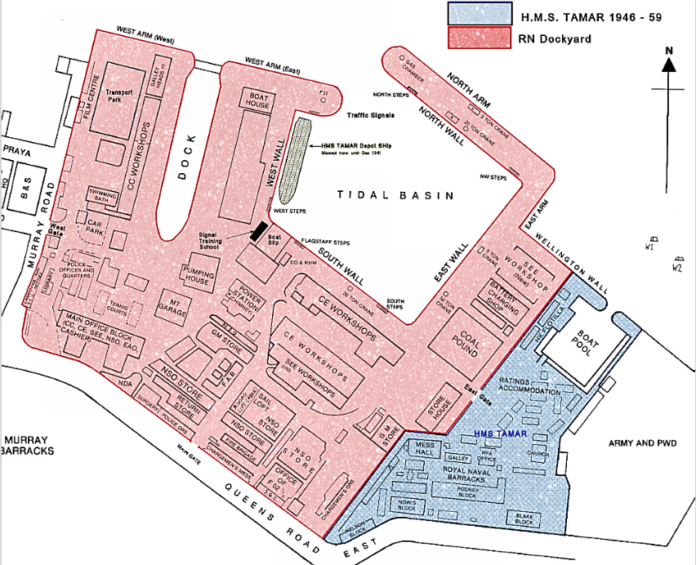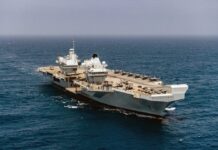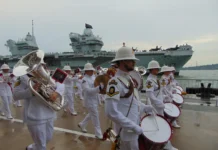
From the Davy Jones’s Locker
In the second of the series of reaching into Davy Jones’s Locker and the early editions of the Journal of the Australian Naval Institute, the first of the very popular ‘Shiphandling Corner’ articles is reproduced. Commander Robin Pennock, who was a non-specialist ‘salthorse’ and served as the Journal Editor from 1980-1983, looked after Shiphandling Corner and invited members to offer “difficult or awkward shiphandling problems and how the situation was retrieved (and if it wasn’t – why not).” Subsequent comments from members were be printed in succeeding editions.
What Happened?
This incident occurred at Victoria Basin, HMS Tamar, Hong Kong. The ship was a Daring Class destroyer and she had been given a berth on East Wall, bows south. The geometry of this problem is worth looking at on the chart. Having entered the basin, the ship had to turn through about 70o, from memory, in about 1½ ship’s lengths. It was possible, but much would depend on conditions and the wind in particular. Once inside the basin, the flood which would be running strongly at the time would of course have no effect.
As the ship passed North Point a reasonably stiff easterly was blowing, and this was welcomed. It was considered it would allow the necessary steep approach and help blow the bows around. At the basin, HMS Fearless was outside on the North Arm, but inside appeared quite empty.
A normal approach was made with a good wide sweep through the Star ferries’ tracks and, as the run to the entrance was made, it was seen that an RN frigate was berthed inside on North Wall. This further reduced the room to turn and added to the problems. Worse still, the easterly had shifted to become a light westerly. As the Bull’s Nose came nearer the Navigator remarked, “We should now be out of the flood”. No sooner had it been said than the tide moved the ship rapidly towards the all too solid sea wall in front of Tamar. A few quick corrections sorted that out, but it had altered the line of approach and had been, to say the least, unsettling. The turn to starboard was hampered by the RN frigate reducing the area to port for the stern to swing and as the westerly breeze started to catch the ship, the starboard anchor was let go, By then the bows were getting too close to the wall to go any further ahead and there was very little room astern. So the two tugs standing by were secured, and the ship was berthed using them.
What Self Criticism is Offered?
It would have been much better handled with a more realistic plan. It had been decided that the worst possible position to get into was to be at an angle between East and North Wall with the bows near the former and the stern near the latter. Ironically it was just this worst case which developed. In hindsight, there were two, or maybe three, important mistakes. Firstly, it was unwise to enter the basin with so much tide running. It would have been better to wait, anchoring in Junk Bay if necessary, until conditions were better.
Secondly, it would have been simple enough to ask Commodore Hong Kong if there were any ships in the basin, and adjust the berthing plan accordingly. Finally and most importantly, two tugs were available, so why try to prove that it could be done without them? The best plan, I believe, would have been to get safely into the basin, stop, button on the tugs, and make a cold move of it. Very simple, no fuss and quite seamanlike; much more so than taking on a difficult task with engines, rudder and anchor. The tugs were available and had to be used anyway, as it turned out.
Lessons Learnt
Always make it easy for yourself. The hard ones develop all on their own; save your strength for them.
A Professional Wrecker’s Comment
Berthing on the East Wall of Victoria Basin is not an easy evolution. The points mentioned under “Self Criticism” – State of Tide, Local information and Use of Tugs – need no further amplification.
Entering Hong Kong through Sulphur Channel and approaching from West may have been preferable in this case. The advantages are:
- slow steady approach to the basin,
- basin entrance and berth is visible to the command earlier,
- approach track cuts across Star ferries track at right angles which is preferable to making a wide sweep through the tracks.
Cyclops


